Waveshare has launched an ESP32-S3-based thermal imaging camera module based on the same 80 x 62 infrared camera found in its Thermal-45/90 camera Raspberry Pi HAT and Thermal-45/90 USB camera.
The thermal camera module is offered with two field of views, namely 45° for the basic version and 90° for the wide angle variant, twenty solder pads with GPIOs, UART, and I2C for expansion, a USB-C port for power and programming, and a 2-pin header to connect a battery if required.
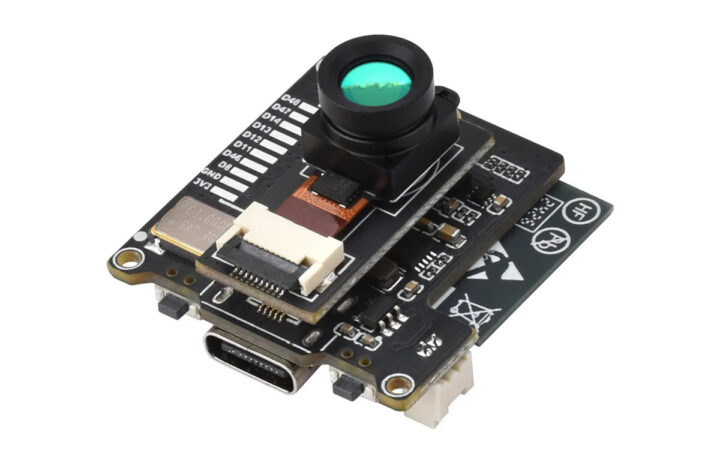
Waveshare “ESP32-S3 IR thermal imaging camera module” specifications:
- Wireless Module ESP32-S3-WROOM-1
- MCU – ESP32-S3 dual-core Tensilica LX7 up to 240 MHz with 512KB SRAM, up to 8MB PSRAM
- Storage – 16MB flash
- Wireless – WiFi 4 and Bluetooth LE 5
- Thermal Camera – Meridian Innovation MI0802
- Resolution – 80 × 62
- Field of View (FOV)
- 56°(D) x 45°(H) x 34°(V) (Baisc version)
- 122°(D) x 90°(H) x 67°(V) (Wide angle version)
- Temperature Range – -40°C to +400°C
- Accuracy – ±2°C
- Refresh Rate – Up to 25 FPS; Note: due to the influence of WiFi signals, there may be errors in the actual frame rate
- Interface – Connected to ESP32-S3 module via SPI
- USB – USB Type-C port for power and programming
- Expansion – 2x 10 solder pads with 14x GPIO, 1x I2C, and 1x UART
- Misc
- RGB LED for real-time status monitoring
- Reset and BOOT buttons
- Power Supply
- 5V via USB-C port
- 2-pin battery connector for 3.7V Lithium battery
- Dimensions – 29 x 29 mm
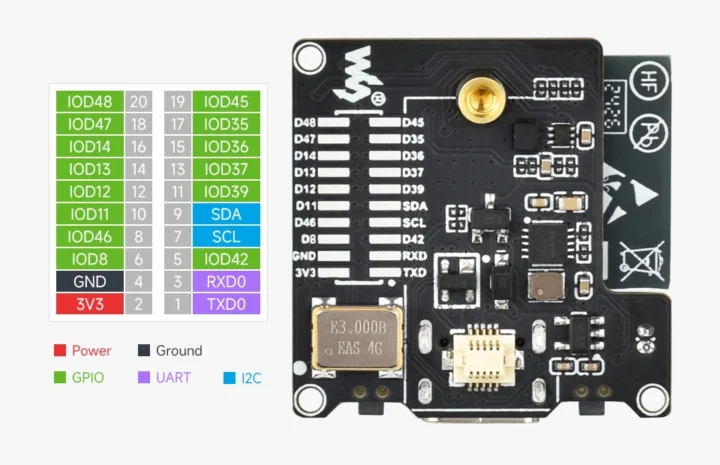
The ESP32-S3 module is preloaded with the “senxorESP32S3” firmware that relies on Bluetooth to configure the WiFi parameters through the BlueFi Android app. After configuration, it can be accessed through 192.168.4.1:3333 (AP mode) or <IP_Address>:3333 (Client mode) using the SenXorView program for Windows. That means you need both an Android smartphone and a Windows computer to use the camera with the default firmware unless the module defaults to AP mode if we don’t use the BlueFi app. However, Waveshare did not make that clear…
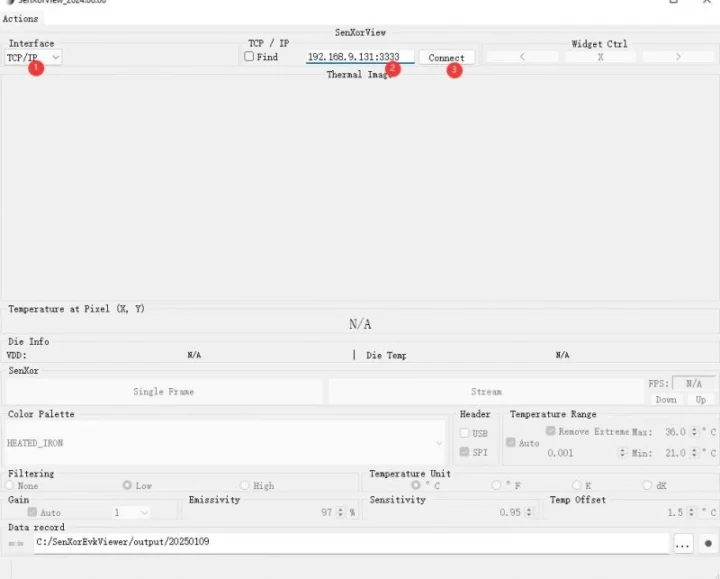
Waveshare did not provide another screenshot or a video demo, but we can see the program supports single frame or video stream mode, and allows for the adjustment of various parameters. You’ll find the firmware (binary and source code), BlueFi Android app, and SenXorView Windows program on the wiki, where instructions to build the firmware with VS Code and the ESP-IDF framework are also provided.
It’s not the first ESP32 infrared camera module we’ve covered, as other examples include the M5Stack Thermal Camera 2 Unit and tCam-Mini IR thermal camera board with respectively 32×24 and 160×120 thermal imagers. The Waveshare model is based on ESP32-S3 instead, whose vector extension could potentially be used for AI-accelerated computer vision, and offers a different resolution (80×62) between those two.
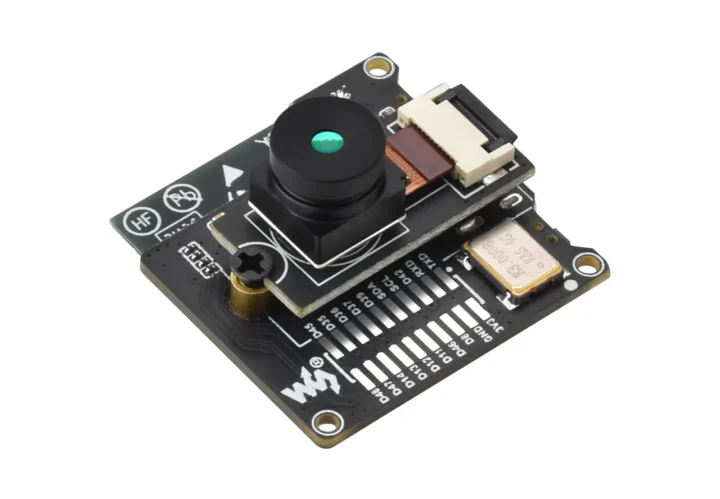
Waveshare’s ESP32-S3 IR thermal imaging camera module can be purchased on AliExpress for $92.69 plus shipping, Amazon for $106.99 (basic version or wide angle version), or the Waveshare shop.

Jean-Luc started CNX Software in 2010 as a part-time endeavor, before quitting his job as a software engineering manager, and starting to write daily news, and reviews full time later in 2011.
Support CNX Software! Donate via cryptocurrencies, become a Patron on Patreon, or purchase goods on Amazon or Aliexpress


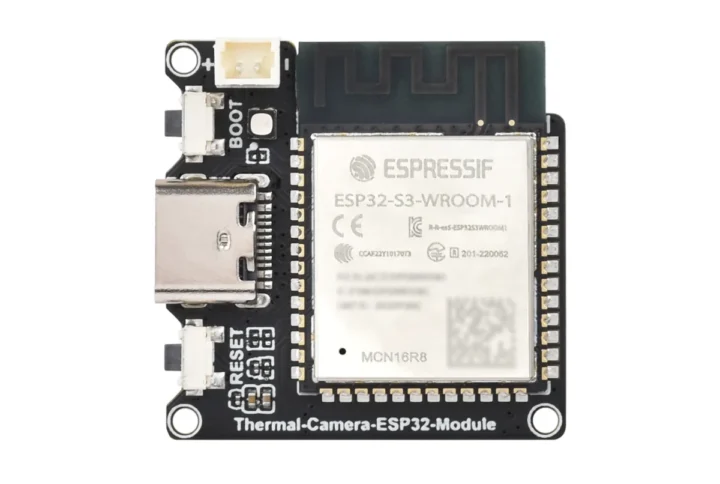



Any previews of the images it can capture?
I could not find any for the ESP32-S3 module per se, but the product page on Meridian Innovation has this for their 80×62 and 160×120 thermal cameras.
Is it common for such sensors to have such low resolution?
Yes. That’s because higher-resolution thermal cameras (up to 1280 x 1024 for FLIR models) are really expensive, and low-resolution cameras are still usable, depending on the application.
There are many thermal sensors with even lower resolutions. The MLX90640 has 32×24. The AMG8333 is only 8×8. It’s a matter of application. Many are just single-point. Thermal sensors are a lot more expensive than regular video sensors for the same resolution.
Thermal sensors with really high resolutions have for a long time been treated as sensitive technology. I would imagine a low res 8×8 sensor can be of more use if coupled with all purpose optical sensors or with IR. Potentially it could be coupled with something like laser or ultrasound emitters/sensors to do something like range finding. Potentially you could also run one of these thermal imagers on a motion system like a 360 pan/tilt which would allow that low resolution to effectively build a much higher resolution heat map.
Strange that there is never Zigbee support
[ probably, “Zigbee has a defined rate of up to 250 kbit/s”, and a most likely utilization is not only one ir-image each 1-5 seconds(?)
While ‘costly’ in comparison to cheap input devices, there are Zigbee-Wifi-Gateways(?) (thx) ]
What would your use case be if using Zigbee? The thermal sensor to output the temperature readings periodically?
It could give quite a lot of low-bandwidth data, such as “movement” or “there’s someone at X,Y” and so on. But since you need power anyway, WiFi or Ethernet makes more sense (using MQTT for instance).
I worked with a number of thermal sensors and in my humble opinion both movement and someone at X,Y will be very inaccurate. I’m not sure how you define a person based on temperature, unless the sensor is placed in a space where if anything around 37c turns up with certain pixel areas it’s a very high chance of that being human. In that use case, a fairly commonly trained object detection model with a OV2640 camera can do the job for 1/20 of the price.
What about looking for correlation between “intelligent” camera and cheaper temperature sensors. You can look for both IR, temp. range, motion and profiles that the camera is trained to recognize.
I think the main reason is that the power consumption means that it’s quite difficult to have a battery-powered device, so Zigbee isn’t quite useful here. A PoE version would make a lot more sense, though.